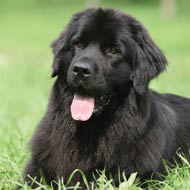
UC Davis vets find mutation responsible for common inherited condition
A team of researchers in California have identified a gene mutation responsible for a potentially deadly heart condition in Newfoundland dogs.
University of California Davis (UC Davis) vets, led by veterinary cardiologist Joshua Stern, have, for the first time, identified the gene responsible for canine subvalvular aortic stenosis (SAS) - a potentially lethal congenital disease that affects Newfoundlands, and other dog breeds including the golden retriever, and is the most common inherited heart disease in dogs.
It is hoped the discovery will pave the way for selective breeding to reduce the prevalence of the condition and lead to the creation of effective treatments.
Joshua Stern says; "Our hope now is that breeders will be able to make informed breeding decisions and avoid breeding dogs that harbor this mutation, thus gradually eliminating the disease from the Newfoundland breed. In addition, now that we know one gene responsible for SAS and more about which proteins are involved, we can move forward to consider novel therapies that may help treat this devastating condition."
The researchers conducted a 'whole genome' analysis, scanning thousands of genes, which revealed that the mutation associated with SAS resides in a gene called PICALM. This same gene mutation has been associated with the formation of plaque-like lesions in the brains of people with Alzheimer’s disease.
The team also conducted a pedigree analysis in a family of 45 Newfoundland dogs to examine the inheritance pattern of the SAS mutation. This analysis confirmed that the inheritance follows a certain pattern, by which only one parent needs to be carrying the gene mutation in order for the offspring to inherit the disease, and that not all dogs carrying the mutation will develop the disease.
SAS shows up in the dog’s heart as abnormal tissue growth, often forming a ridge or ring below the aortic valve, which restricts blood flow from the heart into the aorta.
Diagnosing and treating the disease is particularly challenging because it may appear in mild to severe forms. The first sign that a dog has SAS may be a collapse, fainting spell, irregular heart rate or even sudden death. Veterinarians may discover the disease when they detect a heart murmur and conduct further diagnostic tests such as chest X-rays, an echocardiogram or an electrocardiogram.
Dogs with the mild form of SAS may have a normal lifespan. Those with the severe form, however, are likely to die before they are four-and-a-half years old, even with therapeutic drugs.
SAS is also a condition found in human children. It is rare but when it is diagnosed surgical removal of the ridge or ring below the aortic valve is one option for improving the child's health. However in dogs such a surgical procedure has not increased survival.
The researchers are now beginning to study why SAS is less severe in some dogs while causing severe symptoms in others and are also are examining the genetic basis of SAS in the golden retriever, rottweiler and other dog breeds.
The study has been published in the online journal Human Genetics at www.ncbi.nlm.nih.gov/pubmed/24898977.



 The RCVS has announced a new version of its 1CPD mobile app, with enhanced features for veterinary surgeons and veterinary nurses to record their continuing professional development.
The RCVS has announced a new version of its 1CPD mobile app, with enhanced features for veterinary surgeons and veterinary nurses to record their continuing professional development.